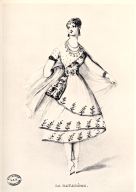 Spotlighting Femininity
Spotlighting Femininity
The figure of the ballerina was conflated with ideal
femininity, ethereal
fantasy and otherworldliness while
simultaneously calling up notions of physicality,
sexuality and the erotic. The contradictions inherent
in the figure of the Romantic ballerina emerge as a result of “the
negotiations that occurred as the prosperous bourgeoisie attempted to balance
their
sense of moral restraint with their need for self-gratification and their
longing for well-being with their denial of social ills.” Nowhere
is this clearer than is the sexually available figure (real or imagined)
of the ballerina. The fantastical
characters of the ballets from this period
had something in common with the women who portrayed them: both were seen
as existing
in a realm outside of and free from social constraints.
The prostitutionalization of
the ballet corps and the spectacle of the ballerina kept dancers, no matter
how renowned, on the periphery of middle-class society. Due to her
visibility outside of the private
sphere of the home, the ballet dancer
automatically fell outside of the realm of female virtue (although not
ideal femininity), which was intimated tied up with the family and domesticity (Lipton 1986).
On the one hand, this kept the dancer on the outskirts of respectable society.
On the other hand, it allowed her a degree of freedom to which most middle-class
women would not have had access. And indeed, the biographers of Fanny Elssler
and Marie Taglioni make it clear that ballerinas of this stature were able
to maintain themselves and their illegitimate children quite comfortably
(Levinson 1977; Guest
1970; & Lee 1999).
However, the girls who made up the corps would not have been so lucky and
prostitution would have provided a viable and necessary means of supplementing
their meager wages.